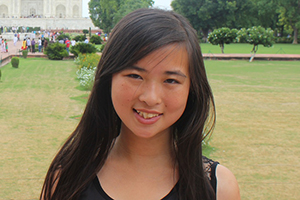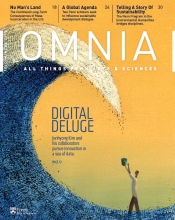Telling a Story Of Sustainability
The Penn Program in the Environmental Humanities bridges disciplines

Most people think of climate change as a scientific issue, measured in degrees and addressed by strategies like alternative energy sources. Now the Penn Program in the Environmental Humanities (PPEH) is creating a fresh and unique forum for academic work on environmental issues.
A collective of scholars, students, and artists, PPEH’s mission is to generate awareness and engagement in the environment by acting as a bridge between disciplines and audiences, and as a lab to develop actions. Originally funded by a grant from Penn’s Green Campus Partnership, the program now has additional support from the office of the Dean of Penn Arts and Sciences and PennDesign’s Kleinman Center for Energy Policy.
PPEH people see part of their role as storytellers of the narrative of nature, but their ultimate goal is action. Program director Bethany Wiggin says, “The program is about generating new thought beyond the science-humanities divide. That includes public programming outlining our role, and student intellectual work that unsettles conventional disciplinary borders.”
Origins
PPEH was the invention of Wiggin, an associate professor of Germanic languages and literatures, and Leah Davidson, a Benjamin Franklin Scholar who worked with her on an independent study on environmental writing. They wanted to create a permanent, interdisciplinary home for sustainability dialogue at Penn.
“There are so many students with different learning styles and different interests,” says Davidson. “With PPEH, you get to see the world through different lenses. It’s really bringing those perspectives to the forefront and seeing the synergies between different disciplines and how they can collaborate.”
Wiggin set the group up to be fully collaborative from the start. “PPEH began because there was so much student demand and interest, so I wasn’t going to tell them what it was about,” she says. She and the original seven research fellows created the group’s plan and goals and organized pubic programming. Each student also carried out a research project on an area of sustainability at the intersection of arts and sciences.

The Colors Of Environmental Art: Leah Davidson
“I believe art can play a big role,” says Leah Davidson, W’16, a management and global innovation major who is minoring in English. “It can evoke emotion or it can be a call to action. It can interact with the environments. It can bridge cultures.”
Davidson used her PPEH fellowship and concurrent role as the undergraduate chair of the Penn Humanities Forum on Color to investigate the symbolism of color in environmental art and photography, and its relationship to human psychology. Visiting galleries and interviewing artists, she analyzed and catalogued 50 significant pieces of art that represented a variety of genres, colors, and cultural heritages.
“I wanted to explore the different focuses environmental art can serve and how it has played different roles in history, and encourage people to integrate that into education,” says Davidson. She found that while the book Silent Spring and Al Gore’s documentary An Inconvenient Truth used scare tactics to encourage people to conserve, she now sees more emphasis on inspiring other emotions and other forms of engagement.
“Environmental art can raise awareness, like Chris Jordan’s digitalizations of the number of cans thrown out in the U.S. per year,” Davidson says. “It can convey the beauty of nature or be made with natural or recycled materials. It can repair damaged ecosystems or reinterpret natural processes.”
Davidson advocates a more cross-disciplinary approach to teaching about sustainability, whether it’s through students going out and exploring or bringing more art education into the classroom or even partnering with different religious groups. “There are so many different ways of thinking about environmental issues,” she says. “And I think that we really need new models for communication and exploration of the environment.”

Environmentally Abroad: Stephanie Businelli
Environmental sustainability is a global issue, but discussions about what to do to ensure it are usually divided by national borders. PPEH fellow Stephanie Businelli, C’16, took advantage of her year abroad at James Cook University in Australia to compare environmental issues and approaches there with those in the U.S.
Businelli, a biological basis of behavior major, talked with students and faculty to develop a more global perspective. She blogged about her conversations and the sustainability programs she saw, such as the way Aboriginal people collect abandoned fishing nets—which are death traps for marine life—and transform them into sculptures that pay homage to the totems and stories of their culture.
As she expected, Australia and the U.S. share many environmental issues, and Businelli hopes her blog will foster a more global perspective and promote discussion that may ultimately lead to courses of action. “It’s a way of telling the story. I hope that when people read it they will see that this is a global issue, and that we need to work together to do something about the problems,” she says. “A national program can help for issues that are contained within a country, like deforestation, but with issues like ocean or air pollution, the approach has to be global.”

Sustainable Space: Austin Bream
How are sustainability efforts affected by the areas in which they take place? “When you walk through a war memorial it’s a completely different feeling than when you walk through a park,” says Austin Bream, C’17, W’17. “You have to ask yourself why, and how can sustainability take advantage of that dynamic?”
For his fellowship, the Huntsman International Studies and Business student documented sustainable spaces in Berlin. The sites ranged from Tempelhof, an airport-turned-park, to the historic Potsdamer Platz, which was completely restored after the Berlin Wall was torn down and now meets Germany’s environmental standards—a unique achievement for such a large area.
Bream’s catalogue of spaces is searchable by characteristics like type of place or the goal of the sustainability effort, and he hopes it will be the seed for a database of sites all over the world.
“Space is a really powerful element, and in really subtle ways it can impact how we see sustainability,” he says. He even included sounds from some of the spaces as another element to consider. “When you hear birds you think of nature, but what about church bells? I want to challenge common assumptions about sustainability.”
Beyond Borders
Last year PPEH also organized a public event series, culminating in “Urban Nature, Natural City,” which brought performance artist, historian, and Urban Rangers Projects co-founder Jenny Price to campus. Urban Rangers members assume the mantle of park rangers and lead participants on tours through public spaces not often identified with nature, as a way of thinking beyond the scope of traditional projects and increasing awareness.
The day also featured a roundtable of experts discussing “Nature in the Anthropocene.” The term anthropocene—the age of the human—signifies a new geological “era” beginning when human activity first began to have an effect on the climate, biodiversity, and trace elements. Panelists included Assistant Professor of History and Sociology of Science Etienne Benson and Associate Professor of Biology Paul Schmidt.
Wiggin and the fellows have worked hard to build outreach across the campus and into the city, including partnerships with the Franklin Institute, Philadelphia Parks, and the Slought Foundation. This year a series of five linked public events will focus on faith, performance, extinction, infrastructure, and engagement, helping the group to construct a “Curriculum for a New Normal” that challenges traditional thought on sustainability. They are also partnering with artist-in-residence Mary Mattingly and her WetLand, a self-sustaining floating studio, residence, and public space where students will live and work.
“It’s weaving together, bringing different disciplines into communication,” says Bream. “Not just academics of different disciplines. It’s also undergraduates and graduates. It’s the youth and the older, Penn and the city.”
The group’s numbers are expanding, too. Last year’s research fellows are mentoring this year’s crop, and graduate fellows have joined the conversation, to conduct their own research and help plan programming.
“It has the energy of a startup,” says Wiggin. “There’s nothing required about PPEH. We are here because we think that this kind of cross-disciplinary cross-fertilization is really going to be important for producing the kinds of knowledge that this changing world really requires and needs.”



